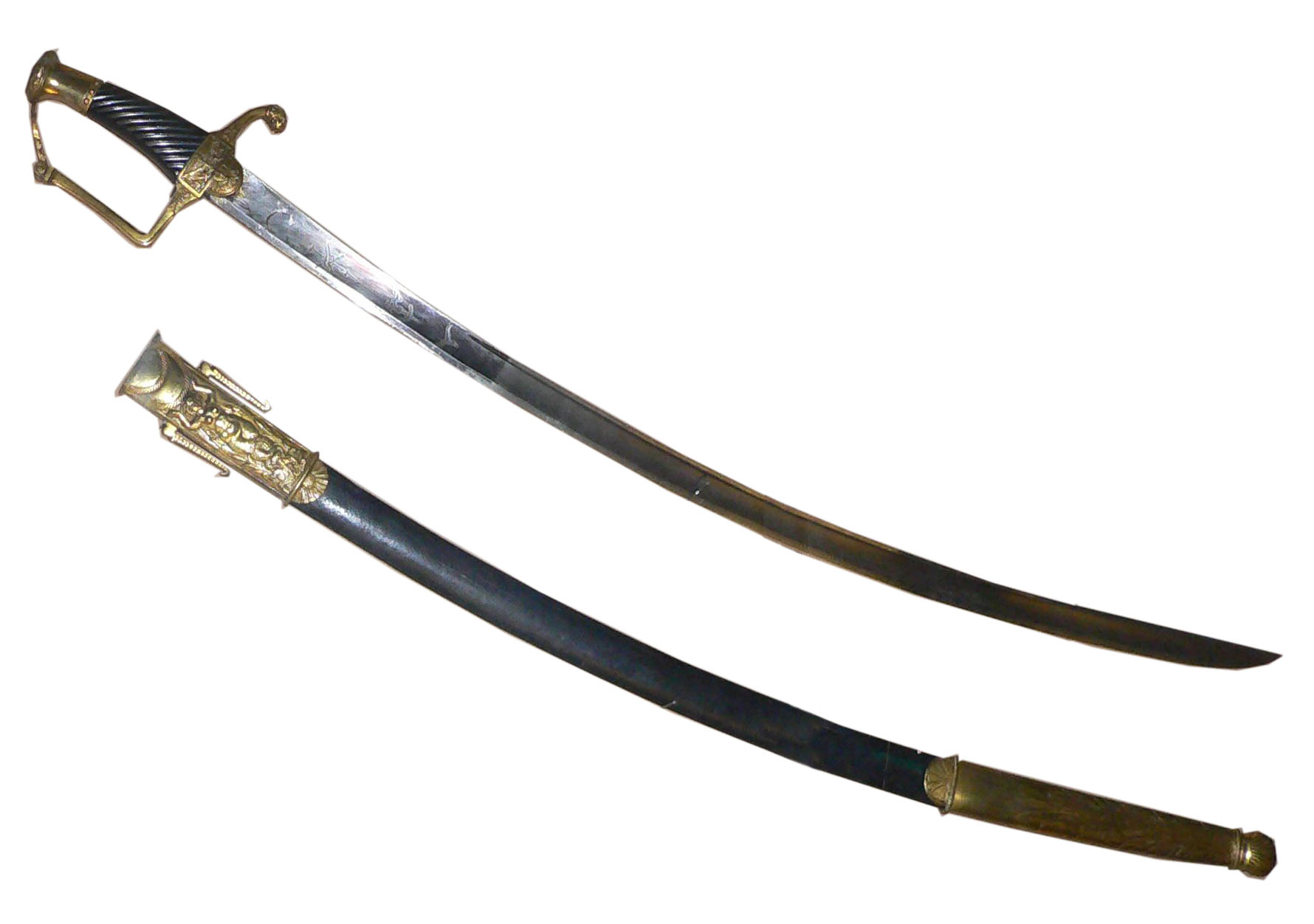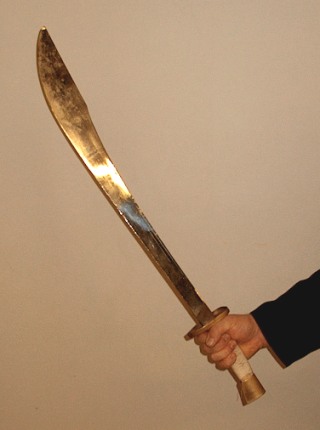|
Single-edged Swords
A single-edged sword is a Classification of swords#Single-edge and curved swords, class of swords with one cutting edge, such as: *Akrafena *Alamang *Amanremu *Aruval *Ayudha katti *Backsword *Balato (sword) *Bangkung *Banyal *Barong (sword) *Batangas (sword) *Bicuco *Bolo knife *Cimpaba *Cutlass *Dahong palay *Dao (Chinese sword) **Butterfly sword **Changdao **Liuyedao **Miaodao **Nandao **Niuweidao **Piandao **Wodao **Yanmaodao **Zhanmadao *Dao (Naga sword) *Dha (sword) *Falcata *Falchion *Falx *Flyssa *Gari (sword) *Gayang *Golok *Hengdang *Hook sword *Hunting sword *Hwandudaedo *Khyber Knife *Kabeala *Kampilan *Kastane *Khopesh *Kirpan *Klewang *Kopis *Kukri *Lahot *Langgai Tinggang *Laring *Luwuk (sword) *Makhaira *Mandau (knife) *Messer (sword) *Moplah sword *Ngulu (weapon) *Niabor *Panabas *Pandat *Paramerion *Parang (knife) *Parang Nabur *Patag (sword) *Pichangatti *Pinutí *Pirah *Ram-dao *Rhomphaia *Sabre **Dusack **Karabela **Shashka **Swiss sabre **Szabla **Turko-Mongol ... [...More Info...] [...Related Items...] OR: [Wikipedia] [Google] [Baidu] |
Dahong Palay
The dahong palay (also spelled ''dinahong palay'', ''dahon palay'' or ''dahompalay''), literally "rice leaf" in Tagalog, is a single-edged sword from the Tagalog provinces of the Philippines. It was originally used by farmers to clear thick grass growth. However, during the Philippine revolution of 1896, farmers from Batangas soon came to favor it for its "slashing and thrusting" feel. Etymology The sword's name could either be a reference to the similarity of its shape to the leaves of rice or to local green "''dahong palay''" snakes, purported to be extremely venomous. The snake is probably the green specimen of the Philippine pit viper (''trimeresurus flavomaculatus)'', though sometimes identified as various relatively harmless green snakes, like vine snakes. Physical description The ''dahong palay's'' size is about the same as most Filipino swords such as the kalis, golok, or ''ginunting'', measuring about twenty to thirty inches. Blade The blade is single-edged and ... [...More Info...] [...Related Items...] OR: [Wikipedia] [Google] [Baidu] |
Dha (sword)
Dha (; also spelled ''dah'') is the Burmese word for "knife" and "sword" similar term to daab or darb () in Thai language for a single edge sword. The term dha is conventionally used to refer to a wide variety of knives and swords used by many people across Southeast Asia, especially present-day Myanmar (Burma), Thailand, Yunnan, Laos, and Cambodia and Northeast India. Origins The broad use and diffusion of the dha across Southeast Asia makes it difficult to attribute the definitive origin. The dha may have its origins with the Burmese people and Tai people who migrated to the area from present-day Yunnan Province in southern China. The Khmer and Mon peoples were well established before the arrival of the Tai or the Burmese people; perhaps they invented the dha as 13th-century reliefs at Angkor depict the weapon. The history of the region includes many periods where one or the other of these groups dominated, bringing along their culture and weapons to conquered areas. Si ... [...More Info...] [...Related Items...] OR: [Wikipedia] [Google] [Baidu] |
Dao (Naga Sword)
''Dao'' is the sword of the people of Northeastern India, mainly in the Indian states of Nagaland, Mizoram, Manipur, Assam and Kachin, Sagaing region of Myanmar. The sword, with its wooden hilt, and unique square form is used for digging as well as used in historical warfare. In modern times, it is generally used for cutting meat and wood. Form The ''dao'' broadsword can be found in Nagaland, Manipur, Arunachal Pradesh, Mizoram and Assam Assam (, , ) is a state in Northeast India, northeastern India, south of the eastern Himalayas along the Brahmaputra Valley, Brahmaputra and Barak River valleys. Assam covers an area of . It is the second largest state in Northeast India, nor ... in the northeastern region of India and Kachin, Sagaing Region, Saigaing region of Myanmar. The dao has a thick and heavy form, which varies in length from to . The unique design of this long backsword is that, instead of a point, the tip of the sword is a bevel which creates the appearance ... [...More Info...] [...Related Items...] OR: [Wikipedia] [Google] [Baidu] |
Zhanmadao
The ''zhanmadao'' () was a single-bladed anti-cavalry Chinese sword. It originated during the Han dynasty (206 BC – 220 AD) and was especially common in Song dynasty, Song China (960–1279). General characteristics The ''zhanmadao'' is a single-edged Dao (Chinese sword), sabre with a long broad blade, and a long handle suitable for two-handed use. It was used as an anti-cavalry weapon, dating from Emperor Cheng of Han, made to slice through a horse's legs. This is mentioned in the ''Wujing Zongyao'', a Song military manual from 1072. It featured prominently against the Jin dynasty (1115–1234), Jin armies in campaigns between 1129 and 1141. The earliest variant of the ''zhanmadao'' is called ''zhanmajian'' (), literally "horse beheading ''jian''". The ''zhanmajian'' existed during the Han dynasty, so called because it was supposedly able to cut off a horse's head. The difference between the two is that ''zhanmajian'' is double-edged whereas the ''zhanmadao'' is single-edg ... [...More Info...] [...Related Items...] OR: [Wikipedia] [Google] [Baidu] |
Yanmaodao
The ''yanlingdao'' () or ''yanmaodao'' () is a type of ''dao'' used as a standard military weapon during the Ming dynasty and middle Qing dynasty (1368–1800). The blade is straight until the curve begins around the center of percussion along the last 1/4 or so of the blade approaching the tip. The center of percussion is the point on the blade with the least vibration on hard contact, the spot on the blade that transmits the most power to the target in a hard chop. This allows for thrusting attacks and overall handling similar to that of the ''jian'', while still preserving much of the ''daos strengths in cutting and slashing. This type of sword seems to have lost its popularity with military and martial arts practitioners alike by the end of the 18th century, being eclipsed by the more curved liuyedao in the military, and the more broad Oxtail Dao in civilian and martial art settings. ''Yanmaodao'' almost invariably have straight grips, although downward-curved handles are ... [...More Info...] [...Related Items...] OR: [Wikipedia] [Google] [Baidu] |
Wodao
The ''wodao'' () is a Chinese sword from the Ming dynasty and Qing dynasty. It is typically long and slender, but heavy, with a curved back and sharp blade. It bears a strong resemblance to the Tang sword, ''zhanmadao'', ''tachi'' or '' ōdachi'' in form. Extant examples show a handle approximately long, with a gently curved blade long. The Chinese word ''wo'' literally means "Japanese", so ''wodao'' literally means "Japanese sword". The term ''wodao'' sometimes refers to Japanese swords, but it mainly refers to similar swords developed in China with Japanese swords used as reference. Chinese ''wodao'' was developed based on the Japanese sword used by the ''wokou'' pirates, a mixed group of Japanese and Chinese who repeatedly looted on the Chinese coast.Rekishi Gunzo. (2 July 2011) ''The Complete Work on Strategic and Tactical Weapons. From Ancient China to Modern China''. Gakken. Qi Jiguang (1528-1588 AD), a general of the Ming Dynasty, studied ''wokous tactics and Japanese sw ... [...More Info...] [...Related Items...] OR: [Wikipedia] [Google] [Baidu] |
Piandao
The ''piandao'' (片刀) is a type of Chinese sabre (''dao'') used during the late Ming dynasty and through the Qing dynasty. A deeply curved dao meant for slashing and draw-cutting, it bore a strong resemblance to the Persian shamshir. A fairly uncommon weapon, it was generally used by skirmishers in conjunction with a shield. See also * Dao (sword) * Dadao * Oxtail Dao *Yanmaodao The ''yanlingdao'' () or ''yanmaodao'' () is a type of ''dao'' used as a standard military weapon during the Ming dynasty and middle Qing dynasty (1368–1800). The blade is straight until the curve begins around the center of percussion along ... * Liuyedao Chinese swords {{China-hist-stub ... [...More Info...] [...Related Items...] OR: [Wikipedia] [Google] [Baidu] |
Niuweidao
The ''niuweidao'' () was a type of Chinese saber ('' dao'') of the late Qing dynasty period. A heavy bladed weapon with a characteristic flaring tip, it is the archetypal "Chinese broadsword" of kung fu movies today. It was first recorded in the early 19th century (the latter half of the Qing dynasty) and only as a civilian weapon: there is no record of it being issued to Imperial troops, and it does not appear in any listing of official weaponry. Its appearance in movies and modern literature is thus often anachronistic An anachronism (from the Greek , 'against' and , 'time') is a chronological inconsistency in some arrangement, especially a juxtaposition of people, events, objects, language terms and customs from different time periods. The most common typ .... References Rerefence paper * * {{Sword-stub Chinese swords ... [...More Info...] [...Related Items...] OR: [Wikipedia] [Google] [Baidu] |
Nandao
A ''Nandao'' () is a kind of '' dao'', or single-edged sword, that is used in contemporary wushu taolu.' Ratified for use by the International Wushu Federation in 1992, it has gained widespread popularity worldwide and has become one of the main events at wushu competitions. History Creation In the 1980s with the development of modern wushu taolu, professors of the Chinese Wushu Association wanted to find a sword or short weapon that would compliment the empty-hand style of nanquan. Among the candidates for consideration were the nine-ring sword, the butterfly sword, the dadao, and the Ghost-head sword, but they were all deemed impractical. During the construction of a compulsory nangun routine, professor Wang Peikun met with Zhou Susheng, coach of the Guangxi Wushu Team to discuss the creation of a new type of sword, the nandao. They found a sword-maker to create prototype nandao sword which were given to the coaches. Wang and Zhou discussed creating a routine fo ... [...More Info...] [...Related Items...] OR: [Wikipedia] [Google] [Baidu] |
Miaodao
The ''miaodao'' (苗刀) is a Chinese two-handed '' dao'' or saber, with a narrow blade, long hilt, and an overall length of or longer. The name means "sprout saber", presumably referring to a likeness between the weapon and a newly sprouted plant. An early reference, in Jin Yiming's ''Single Defense-Saber'', makes a connection between the ''miaodao'' and the Qing-era '' wodao'', as well as mentioning both single and two-handed versions of the ''miaodao'', suggesting that the name originally described the shape only, without any connotations of size. While the ''miaodao'' is a recent weapon, the name has come to be applied to a variety of earlier Chinese long sabers, such as the ''zhanmadao'' and ''changdao''. Along with the '' dadao'', ''miaodao'' were used by some Chinese troops during the Second Sino-Japanese War. While the ''miaodao'' is rarely practiced in modern Chinese martial arts, some schools of Piguaquan and Tongbeiquan (in the Guo Changsheng lineage) and Xingyiqu ... [...More Info...] [...Related Items...] OR: [Wikipedia] [Google] [Baidu] |
Liuyedao
The ''liuyedao'' or "willow-leaf saber" is a type of ''dao'' that was commonly used as a military sidearm for both cavalry and infantry during the Ming and Qing dynasties. A descendant of the earlier Mongol sabre the liuyedao remained the most popular type of single handed sabre during the Ming dynasty, replacing the role of the ''jian'' as a issued weapon in the military.Tom 2005, pp. 77-78 Many schools of Chinese martial arts Chinese martial arts, commonly referred to with umbrella terms Kung fu (term), kung fu (; ), kuoshu () or wushu (sport), wushu (), are Styles of Chinese martial arts, multiple fighting styles that have developed over the centuries in Greater Ch ... originally trained with this weapon. This weapon features a moderate curve along the length of the blade. This reduces thrusting ability (though it is still fairly effective at same) while increasing the power of cuts and slashes. The hilts are typically straight, but can be re-curved downward startin ... [...More Info...] [...Related Items...] OR: [Wikipedia] [Google] [Baidu] |



